
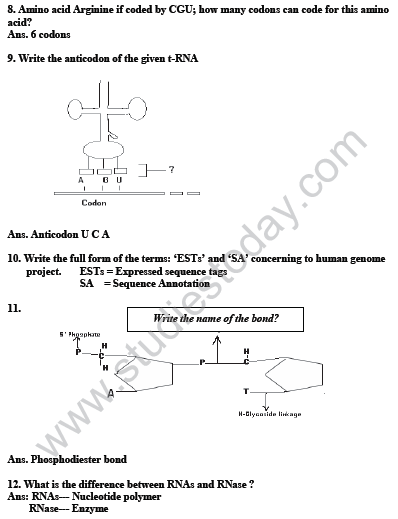
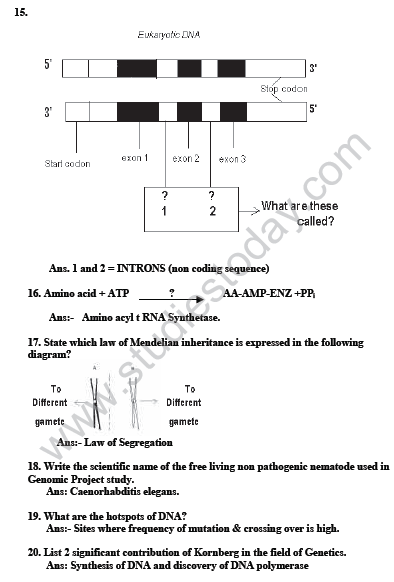
21. There is a large increase in absorption of Ultraviolet radiation of 260nm by melted DNA as compared to intact DNA. What is this differential effect called?
Ans: Heterochromatic effect.
22. What kind of inheritance is seen in haemophilia?
Ans: Sex linked inheritance
EVOLUTION
23. Why do the animals have certain functionless organs in their body?
Ans.In the course of evolution due to change in mode of life few organs remained functionless and gradually reduced in to remnants of past as an evidence to evolution.
24. Which of the following are homologous organs?
a) Trunk of an Elephant and forelimbs of a Monkey
b) Wings of a bird and wings of butterfly
Ans: None
29. Which of the following are analogous organs?
a) Legs of Cockroach and legs of Cat.'
b) Pectoral fin of fish and forelimb of a frog.
Ans: (a)
30. Wing of bat is homologous to
a) Arm of a human
b) Tail of a kangaroo
c) Wing of a butterfly
Ans: (a)
31. Can we call human evolution as an ‘Adaptive radiation’?
Ans Yes
32. What is ‘saltation?’
Ans: Single step large Mutation
33. What is meant by genetic equilibrium?
Ans: When allele frequencies in a population is stable and gene pool remains constant it is called genetic equilibrium.
34. What is ‘Founder effect’?
Ans: Change in allele frequency of an original drifted population which becomes a different species and the founder.
35. What is’ genetic drift’?
Ans Change in the gene or allele frequencies of a population that occurs by chance.
36. Name the common ancestors of Apes and Man.
Ans: Ramapithecus
37. Give the Scientific name of first human like ancestors.
Ans: Homo habilis
2 MARKS QUSTION
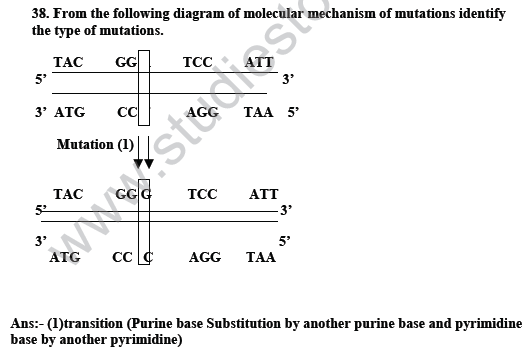
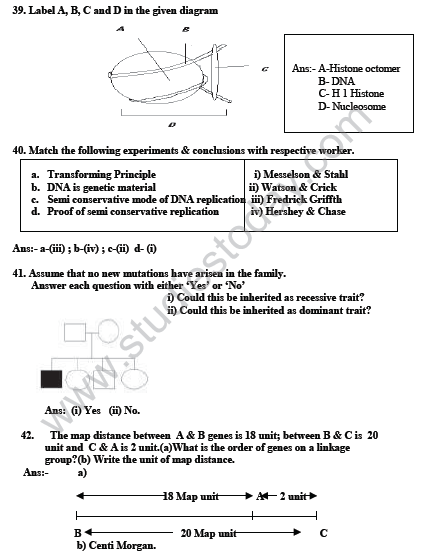
43. Colour blindness is a recessive trait. A couple with normal vision has two sons one colour blind and one with normal vision. If the couple also has daughters what proportion of them will have normal vision?
Ans:- All daughters will have normal vision.
44. In a cross between a black and a white guinea pig, all F1 members are black but F2 generation raised by crossing two such F1 consists of approximately ¾ black & ¼ white guinea pigs.
a) What are possible genotypes of the F2 generation?
b) What will be the type of offsprings produced when two F2 white are z mated?
Ans: a) BB-Black; Bb- Black; bb- White.
b) All White.
46. Write the full form of RFLP, SNP
Ans:- Restriction Fragment Length polymorphism Single Nucleotide Polymorphism
47. Which is the longest known human gene and the number of bases present in it.
Ans:- Dystrophin gene in human with 2.4 million bases.
48. What do you mean by SNPs and its significance with respect to human genome?
Ans: ‘Single Nucleotide Polymorphism’ Used for finding chromosomal locations for disease associated sequences and for tracing human history
49. Recombination frequency between two genes white(W) and miniature wing(m) is 37.2% .what is the distance between genes ‘W’ and ‘m’.
Ans: Recombination frequency between two genes = distance between two genes = 37.2 map units(centiMorgan).
50. Drosophila has four pairs of chromosomes and Human has 23 pairs ofchromosomes. How many linkage groups will each have?
Ans :Drosophila - 4 linkage groups
Human Being - 23 linkage groups
51. ZO-ZZ type mechanism occurs is honey bee for Sex-determination and the female Bee has 32 chromosomes.
i) What is the number of chromosomes in male Bee?
ii) Which cell division will the male perform for gametogenesis?
Ans: i) 16 (Haploid) ii)Mitosis
52. Identify the type of ‘Mutation’ occurring in the following diagram and name the ‘Disease’.
Ans: Point mutation. The disease is Sickle cell anaemia
EVOLUTION
54. How can you explain the existence of analogous organs?
Ans: Some organs developed in the course of evolution as adaptation of different organisms to a similar mode of life.
55. i) What is differential reproduction?
ii) How does it help in evolution?
Ans: i) Varying degrees of success with which individuals of a population reproduce.
ii) Reproductively fit individuals leave more progeny than others and are elected by nature to survive and evolve into new species.
56. Give two reasons why life cannot originate today.
Ans: 1) Atmosphere is oxidizing so any molecule syntheised will be oxidized.
2) Other organisms devour any molecule formed.
57. Differentiate ‘Gene flow’ and ‘Genetic drift’.
Ans: Gene flow Genetic drift
•Change in allele frequency of apopulation •Change in allele frequency of apopulation
• Due to migration • Occurring by chance
58. When and where did Neanderthal man live? What was his brain capacity?
Ans: between 1,00,000-40,000 years back. Lived near East and Central Asia. Brain capacity 1,400cc.
3 mark questions
59. Mention the steps involved in the following Pea plant cross
Removal of anthers---------------------- A ↓
↓
Transfer of Pollen------------------------ B
↓
Raising the next generation-------------C
Ans:- A- Emasculation, B- Pollination C- Hybridisation (Crossing)
60.What is ‘UTR’? Where is it located? Write its significance.
Ans:- Untranslated regions in mRNA. Present at both 5’ end (before start codon) and at 3’ end (after stop codon). They are required for efficient translation process.
61. The area with long sequence of short repetitive DNA is called Satellite DNA. These are of two types like microsatellite & minisatellite. On what basis they Are called so? Where do they occur generally?
Ans:- Microsatellites have 1-6 bp repeat units.
Minisatellites have 11-60 bp repeat units. So they are called accordingly.
They occur specifically near ends of chromosomes (telomere),
centromeres,pericentric and other heterochromatic areas.
62. Give two examples each for linear and circular DNA. Why are they called so?
Ans: Linear DNA- (i)All Eukaryotes (Human DNA,)
(ii) DNA Virus ( Rubella virus)
Circular DNA (i) Bacterial DNA
(ii) Mitochondrial DNA
They are called so since in linear DNA ends are free and in circular they are covalently linked.
63. E.coli was cultured in a medium contaning 15NH4Cl(15N is the Heavy isotope of nitrogen) .After first generation E.coli was extracted and transferred to culture medium having 14NH4Cl(Normal nitrogen medium).
a) What is the time duration by which E.coli completes it’s first generation
b) At 40thminute what would be the nature of DNA
c) AT 80 thminute what would be the nature of DNA and it’s proportion.
Ans. a) E.coli completes it’s first generation by 20 minutes
b) At 40thminute the nature of DNA would be intermediate density with both 14N & 15N.
c) AT 80 th minute composition of DNA is light chain : hybrid chain = 3:1
64. Genomic mutation is the term used for change in chromosomal number, Write its two types and mention where they are seen?
Ans: a) Euploidy - Increase in the whole set of chromosome. Generally seen in plants(Triticale)
b)Anueploidy – One chromosome less (Turner’s Syndrome) OR one chromosome more (Klinefelter’s Syndrome)
65.From the given monohybrid ratio identify the type of inheritance and give one example each.
i) Both phenotypic and genotypic ratio is 1:2:1
ii) Phenotypic ratio is 3:1 and genotypic ratio is 1:2:1
Ans: i) Incomplete Dominance eg: Snap Dragon
ii) Complete Dominance eg: Pea plant
66)
.

(i)What do you infer from this schematic representation
(ii)Label A, B, C, D & E
Ans: (i) It shows heterogenous nuclear RNA ‘Capping’&’Tailing’
(ii) A – Methylated G Cap
B – Initiation Codon (AUG/GUG)
C – Coding region
D – Termination codon
E – Poly ‘A’ Tail
67 .When and where did Neanderthal man live?What was his brain capacity?
Ans: Between 100000-40000 years back.Lived near East and Central Asia.Brain capacity 1400cc.
68.Give three examples for ‘Homology’ which occur in the stem of some plants.
Ans: a) Passiflora(Stem tendril-clinging stem)
b) Bougainvillea(Stem thorn-Defence)
c) Cucurbita (Stem tendril - climbing)
69.What is the evolutionary significance of the following figure & label A,B,C &D?
Ans: Analogy in tendrils of different plants show functional similarity though the structure and origin are different that proves convergent evolution.
A –Stipular tendril
B – Leaf tip tendril
C – Stem tendril
D – Leaflet tendril
70. What do the following changes represent in the given graph?
(i) If operation of natural selection makes peak higher and narrower
(ii) if peak shifts to right direction
(iii) If two peaks are formed instead.
Ans: (i) Stabilising (ii)Directional (iii)Disruptive
71. Classify the following as examples of homology and analogy.
(i) Hearts of fish and crocodiles
(ii) Eyes of octopus and mammals
(iii) Wings of butterfly and birds
(iv) Tubers of sweet potato and potato
(v) Thorn of bougainvillea and tendril of cucurbita
(vi) Forelimb of whale and forelimb of a Bat
Ans Homologous - (i)(v)(vi)
Analogous - (ii)(iii)(iv)
5 MARKS QUESTION
72.Identify the structural units of transcription unit
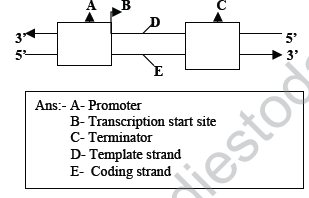
73. Cystic fibrosis is recessive condition that affects about 1 in 2,500 babies. Calculate the following.
a) Name the principle involved
b) the equation used
c) the frequency of the recessive allele in the population
d) the frequency of the dominant allele in the population
e) the percentage of heterozygous individuals (carriers) in the population
Ans:- a) Principle:- Hardy Weinberg’s Equilibrium
b) (p+q)2= p2 +q2 +2pq
c) Recessive allele q2 = 1/2500 so q = = 0.02
d) Dominant allele P= 1-0.02=0.98 (98%)
e) Heterozygous 2pq= 2 (0.98X 00.02)=0.04 or 1 in 25
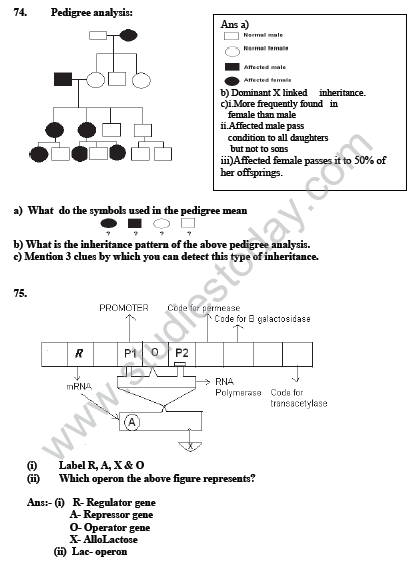
76. Mention whether the male individuals of the following organisms are homozygous/ heterozygous.
i) Human = XY-XX
ii) Hen = ZW-ZZ
iii) Drosophila = XY-XX
iv) Grasshopper = XO-XX
v) Birds = ZZ-ZW
Ans : MALE
i) Human = Heterozygous(XY)
ii) Hen = Homozygous (ZZ)
iii) Drosophila = Heterozygous (XY)
iv) Grasshopper = Heterozygous (XO)
v) Birds = Homozygous (ZZ)
77. Mention the type of error in the following diseases:
1. Sickle cell anaemia
2. Haemophilia
3. Phenylketonuria
4. Down’s syndrome
5. Klinefelter’s syndrome
Ans :1.Autosomal recessive
2.Sex linked recessive
3.Autosomal recessive Metabolic error
4.Autosome 21 Trisomy
5.Sex chromosome Trisomy XXY
78. (i) Label the diagram ……1,2,3,4,5and 6 (ii) State whether the diagram is of Prokaryotes or eukaryotes
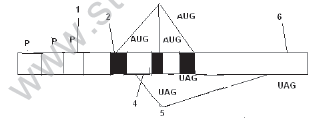
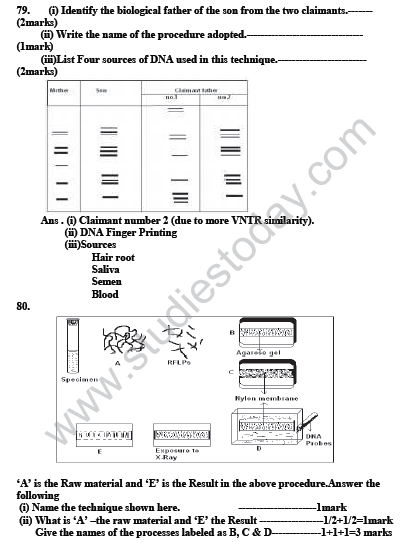
Ans (i)DNA fingerprinting
(ii)A – DNA
B – Electrophoresis
C - Southern Blotting
D – Hybridisation
E - X-ray film with DNA profile
81.
i) Name the scientists who performed this experiment?
ii) What was the inference of the experiment?
iii) Label A, B, C, D, E & F
Ans . i) A.D.Hershey and Martha Chase ------------------------------------- (1 mark)
ii) It is proved that DNA is the genetic material & not protein-----(1 mark)
iii) A – Viral DNA
B – Host DNA
C- Bacteria with Radioactive sulphur (3 mark)
D- Unlabelled Bacteriophage
E - Bacteria with Radioactive Phosphorus
F - Labeled Bacteriophage
82. Duchene’s muscular dystrophy is sexlinked and usually affects only males. Victims of the disease become progressively weaker early in life.
a) What is the probability that a woman whose brother has Duchene’s muscular dystrophy will have an affected child
b) If your mother’s brother had Duchene’s disease what is the probability that you will receive the gene
C) If your father’s brother had the disease what is the probability that you will receive the gene.
Ans. (a) ½ of her children will be sons, & ½ of them will have muscular dystrophy. Overall probability= ½ x ½ x ½ = 1/8
(b) ½ chance that your mother has and a ½ chance that you have it, if you are a male or female. Overall probability= ½ x ½ = ¼
83. . Given below is schematic representation of two interacting bacterial cells :
(i) Name the bacterium and describe the process illustrated?
(ii) What is the use of such a process in genetics?
(iii)Which of the two cells act as a male?
(iv) Draw a labeled diagram of the stage immediately next to the one shown here?
Ans: (i) Bacterium E.coli
(ii) It represents Conjugation between donor and recipient
- Portion of DNA comes into recipient
- Incorporation in recipient DNA by replacing equivalent segment
(iii)Cell number 1 is the donor ’Male’
(b)Name the mixture of inorganic substances used in spark discharge.
(c) What was the purpose of the experiment?
(d) How was lightening simulated in this experiment?
(e) Name the compounds synthesized in this experiment?
Ans:(a) Stanely L Miller & C,. Urey 1953
(b) H2 Gas, NH3, CH4 & Water vapour.
(c) To synthesis simple organic compounds from inorganic substances
(d) Electric spark of 75,000 volts from electrodes simulated lightening.
(e) Amino acid,(glycine, alanine, aspartic acid adenine, simple ribose sugar).
85. Give scientific reasons for the following statements.
(i) Process of growth & divisions were not précise & regulated in coacervates.
(ii) Oparin & Haldane theory of origin of life is the most accepted one at present.
(iii) First evolved organisms were heterotrophs & anaerobes
(iv) Abiogenesis is not possible at present.
(v) Ozone sheath was formed in the stratosphere after the origin of life on earth.
Ans:(i) It is so because coacervates lacked nucleic acids.
(ii) Because it has experimental evidence in favour .
(iii) Preformed organic matter were available as food & there was no O2 in the Atmosphere.
(iv) On the primitive earth atmosphere was reducing, so it permitted only Abiogenesis At present oxidizing atmosphere does not allow
(v) Because photoautotrophs sometime after their origin became capable of getting H2 from water & releasing O2 as by product. As O2 accumulated in the atmosphere ,the UV radiations changed some of it into O3
86. Justify the following:-
(i) Modern concept of evolution is considered a synthesis of ‘Darwin-Wallace’s & De Vries’ theories.
(ii) The addition of antibiotics to cattle feed has been banned
(iii) The interspecific hybrids are usually sterile.
(iv) Reproductive isolation ultimately leads to speciation
(v) Prolonged use of pesticides leads to pesticide resistance.
Ans:
(i) Genetic variation (mutations) are only inherited not all variations as held by Darwin. So modern theory is the modification of Darwin-Wallace & Devries theories together.
(ii) Because it makes the cattle fatten & they become breeding ground for antibiotics resistance bacteria.
(iii) Interspecific hybrid receives chromosomes from 2 species & being dissimilar
fail to pair in meiosis, so gametes do not receive full chromosome complement i.e. one of each kind.
(iv) Reproductive isolation causes accumulation of genetic variation in different populations, ultimately turn into new species. Without this, variation may disappear.
(v) Pesticide resistant individuals always occur in all population –multiply, but pesticide sensitive ones die. So existing population comes to consist of pesticide resistance.

